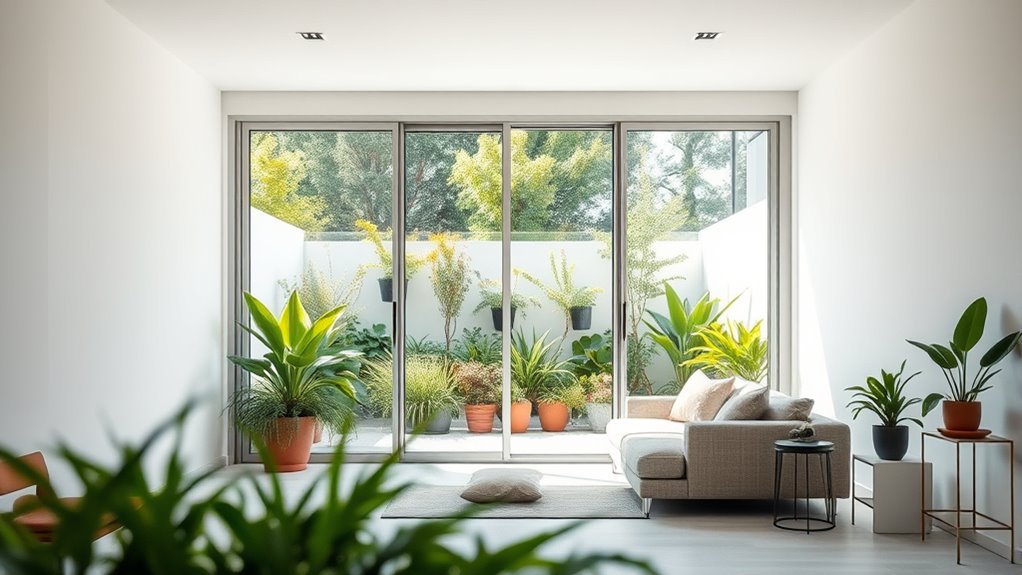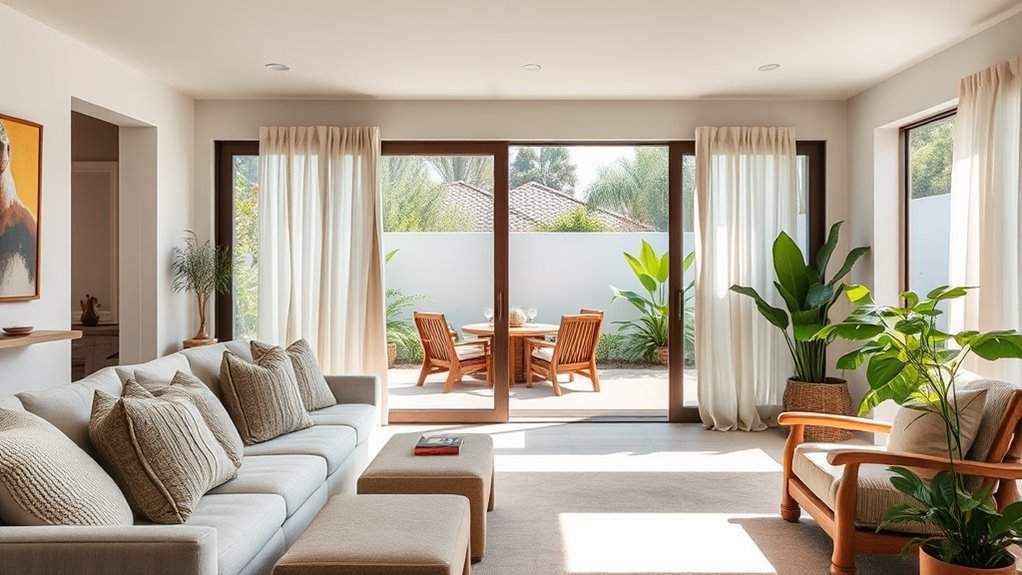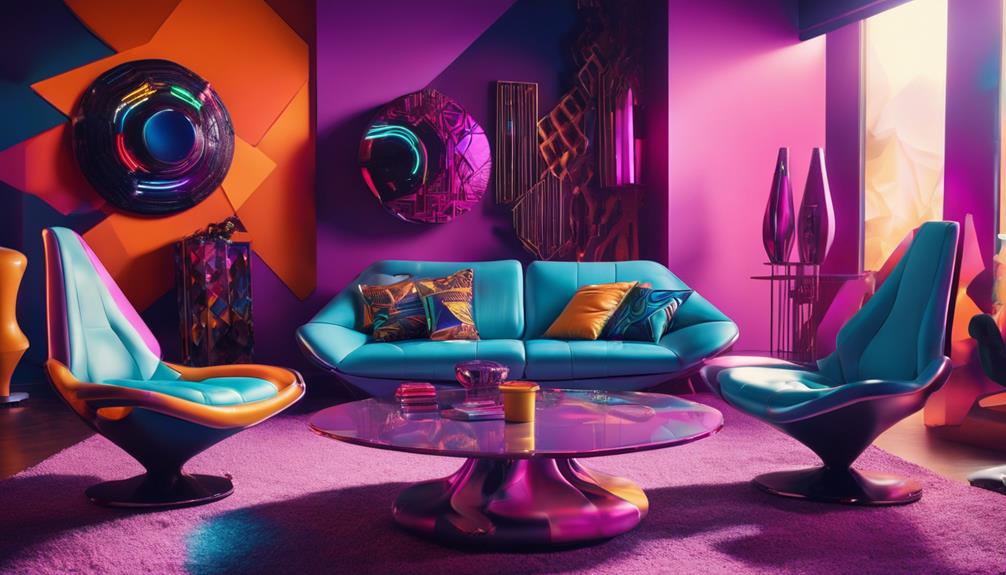To blur indoor‑outdoor boundaries, focus on arranging furniture that promotes flow, like extending indoors to outside and using low-profile pieces. Incorporate consistent lighting styles and warm accents both inside and out. Use similar materials, colors, and textures, and add plants as natural dividers. Choose complementary flooring to create a seamless connection. Small details like matching soft furnishings tie the spaces together, helping you craft a harmonious environment that feels continuous—explore more ways to perfect this flow.
Key Takeaways
- Arrange furniture to encourage movement and visual continuity, avoiding barriers and extending indoor pieces outside.
- Use layered, matching lighting indoors and outdoors to create a seamless ambiance.
- Maintain consistent color schemes, textures, and materials across indoor and outdoor spaces.
- Choose flooring materials that complement each other to ensure a smooth visual transition.
- Incorporate natural elements like plants and textures to unify the overall design and soften boundaries.

Creating a seamless indoor-outdoor flow can transform your living space into a more inviting and functional environment. To achieve this, you need to pay close attention to how your furniture is arranged and how you light each area. Your furniture arrangement plays a vital role in making the transition between inside and outside feel natural. Instead of blocking the view with bulky pieces or creating barriers, opt for a layout that encourages movement and connection. Use low-profile furniture or pieces in similar styles and materials to unify the spaces visually. For example, extending a dining table from inside to outside or placing lounge chairs near sliding doors can create a cohesive look that invites you to move freely between areas.
Arrange furniture to seamlessly connect indoor and outdoor spaces, encouraging movement and visual harmony.
Lighting design is equally important in blurring boundaries. Proper lighting helps to eliminate stark contrasts and create a continuous ambiance. Inside, incorporate layered lighting—think warm overhead fixtures, table lamps, and accent lights—so the space feels cozy and inviting. Outside, choose lighting that complements the indoor look, like string lights, lanterns, or built-in fixtures that cast warm, soft glows. When both spaces share a similar lighting style and color temperature, the transition becomes seamless, especially during the evening hours. Consider installing dimmers on both indoor and outdoor lights to adjust brightness and mood, which further enhances the sense of unity.
To enhance the indoor-outdoor flow, think about continuity in décor elements. Use similar color palettes, textures, and materials in your furniture, cushions, and accessories. Natural woods, rattan, or metal finishes can be used both indoors and outdoors, creating visual harmony. Plants are also an excellent way to connect the spaces, acting as living dividers that soften boundaries without closing them off. Large potted plants near doorways or along patios can visually extend the interior into outdoor areas, making the transition feel effortless.
Don’t forget to consider the flooring as well. Using the same or complementary materials, like stone, wood, or tile, helps to unify the spaces. Transition areas, such as patios or decks, should flow naturally from the indoor flooring, minimizing visual breaks. Small details like matching curtain fabrics or coordinated décor accessories can tie everything together, reinforcing the idea that inside and outside are part of one harmonious space.
A well-designed space planning approach ensures that furniture and layout choices support a smooth indoor-outdoor connection, making your entire home feel more cohesive. In the end, creating a seamless indoor-outdoor flow is about thoughtful design choices that encourage movement and visual continuity. By carefully planning your furniture arrangement and lighting design, you’ll craft an environment that feels both inviting and cohesive—making your home a true sanctuary where indoor comfort and outdoor beauty coexist effortlessly.
Frequently Asked Questions
How Do I Choose Durable Materials for Outdoor Furniture?
When choosing durable outdoor furniture, you should look for weather-resistant fabrics that can withstand rain and sun without fading or tearing. Opt for rust-proof hardware to prevent corrosion over time. Consider materials like aluminum, teak, or resin wicker, which are known for their resilience. By selecting these sturdy options, you guarantee your furniture stays beautiful and functional, even with frequent outdoor use.
What Color Schemes Enhance Indoor-Outdoor Harmony?
Imagine your space as a seamless story waiting to unfold. To enhance indoor-outdoor harmony, choose soothing, neutral color schemes like soft beiges, gentle grays, or warm taupes that gently blend rooms and exteriors. Incorporate subtle accent palettes with earthy greens, blues, or terracotta to add depth without disrupting flow. Thoughtful color coordination creates a tranquil progression, making your outdoor space feel like an extension of your indoors, inviting relaxation and unity.
How Can Lighting Create Seamless Transitions Between Spaces?
You can create seamless progressions between spaces by using layered illumination, combining ambient lighting with task and accent lights. Incorporate soft, warm ambient lighting to gently connect rooms and outdoor areas, making the flow natural. Use dimmable fixtures to adjust brightness as needed, and consider pathway lighting that guides your eye smoothly from one space to another. This layered approach guarantees a cohesive, inviting atmosphere throughout your home and outdoor areas.
Are There Plants That Thrive Both Indoors and Outdoors?
You might wonder if there are plants that thrive both indoors and outdoors. The answer is yes—look for versatile plant choices like snake plants, pothos, and succulents. These climate-adapted greenery options are hardy and easy to care for, making them perfect for blending your indoor and outdoor spaces. By choosing these adaptable plants, you create a seamless progression that enhances your home’s flow and aesthetic appeal.
How to Maintain Privacy While Maintaining Flow?
Did you know that 78% of homeowners want privacy without sacrificing openness? To achieve this, use privacy screens like lattice panels or trellises with climbing plants to create visual barriers. Incorporate soundproofing techniques such as outdoor curtains or water features to reduce noise. This way, you keep an inviting flow while maintaining your privacy, blending indoor and outdoor spaces seamlessly and comfortably.
Conclusion
Imagine your home as a seamless tapestry, where indoor and outdoor spaces weave together like a gentle river merging with the sea. By blending décor elements and opening up your layout, you create a sanctuary that breathes freely and welcomes life from every angle. When boundaries fade, your home transforms into a vibrant, flowing landscape—a place where every moment feels connected, and the outside world becomes an extension of your personal haven.










